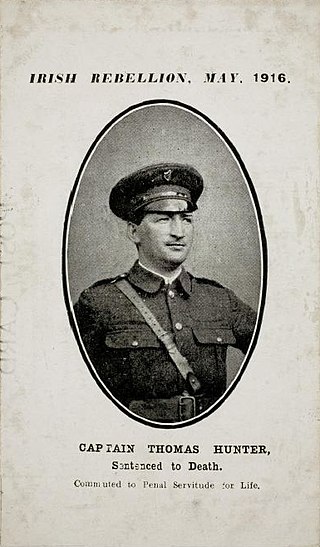The year 1920 in film involved some significant events.

William Carleton was an Irish writer and novelist. He is best known for his Traits and Stories of the Irish Peasantry, a collection of ethnic sketches of the stereotypical Irishman.

The Irish Volunteers, also known as the Irish Volunteer Force or the Irish Volunteer Army, was a paramilitary organisation established in 1913 by nationalists and republicans in Ireland. It was ostensibly formed in response to the formation of its Irish unionist/loyalist counterpart the Ulster Volunteers in 1912, and its declared primary aim was "to secure and maintain the rights and liberties common to the whole people of Ireland". Its ranks included members of the Conradh na Gaeilge, Ancient Order of Hibernians, Sinn Féin and the Irish Republican Brotherhood. Increasing rapidly to a strength of nearly 200,000 by mid-1914, it split in September of that year over John Redmond's support for the British war effort during World War I, with the smaller group opposed to Redmond's decision retaining the name "Irish Volunteers".
Events from the year 1959 in Ireland.
Rapparees or raparees, were Irish guerrilla fighters who operated on the Royalist side during the Cromwellian conquest of Ireland and the Jacobite side during the 1690s Williamite war in Ireland. Subsequently, the name was also given to bandits and highwaymen in Ireland – many former guerrillas having turned to armed robbery, cattle raiding, and selling protection against theft to provide for themselves, their families, and their clansmen after the war ended. They were in many cases outlawed members of the Gaelic nobility of Ireland and still held to the code of conduct demanded of the traditional chiefs of the Irish clans.

Robert G. Vignola was an Italian-American actor, screenwriter, and film director. A former stage actor, he appeared in many motion pictures produced by Kalem Company and later moved to directing, becoming one of the silent screen's most prolific directors. He directed a handful of films in the early years of sound films, but his career essentially ended in the silent era.

The Irish Republican Police (IRP) was the police force of the 1919–1922 Irish Republic and was administered by the Department for Home Affairs of that government.
Donagh MacDonagh was an Irish writer, judge, presenter, broadcaster, and playwright.
The Colleen Bawn, or The Brides of Garryowen is a melodramatic play written by Irish playwright Dion Boucicault. It was first performed at Laura Keene's Theatre, New York, on 27 March 1860 with Laura Keene playing Anne Chute and Boucicault playing Myles na Coppaleen. It was most recently performed in Dublin at the Project Arts Centre in July and August 2010 and in Belfast by Bruiser Theatre Company at the Lyric Theatre in April 2018. Several film versions have also been made.

This is a list of notable people buried in Glasnevin Cemetery.
"Polly Vaughn" is an Irish folk-song.

Thomas Cornelius Hunter was a militant Irish republican. He was a member of the Irish Republican Brotherhood (IRB), Sinn Féin, the Irish Volunteers, was twice elected to the Irish parliament, Dáil Éireann, and fought against the forces of the Irish Free State as a member of the Irish Republican Army during the Irish Civil War. While not widely known today, he was present at or directly involved in several major incidents during the struggle for Irish independence from the United Kingdom of Great Britain and Ireland.

Joseph Michael MacDonagh was an Irish Sinn Féin politician.

Arthur Donaldson, was a Swedish-American actor and opera singer. He appeared in 71 films between 1910 and 1934.

James Mark Sullivan was a lawyer and the Envoy Extraordinary and Minister Plenipotentiary to Santo Domingo under Woodrow Wilson. He was arrested in Dublin in 1916 for aiding the Irish rebellion.
Stephen O'Mara was an Irish nationalist politician and businessman from Limerick.
John MacDonagh was an Irish film director, playwright, republican, and a participant in the 1916 Easter Rising.
The Dáil loans were bonds issued in 1919–1921 by the Dáil (parliament) of the self-proclaimed Irish Republic to raise the Dáil funds or Republican funds, used to fund the state apparatus the Republic was attempting to establish in opposition to the Dublin Castle administration of the internationally recognised United Kingdom of Great Britain and Ireland. The subscribers were Irish nationalists, in Ireland for the Internal Loan and in the United States for the External Loan.
Ellen Scanlon, born Ellen Hanley, was an Irish murder victim. Born to a Limerick farming family in 1803, her murder at age 15 became the subject of books, plays, films, songs, and an opera, using the nickname given to her locally, "the Colleen Bawn,", which translates literally to "white girl," with "white" symbolically meaning purity, innocence, gentleness, or beauty. Thus the name can be interpreted as "the innocent maiden."
The Film Company of Ireland was the first film production company established in Ireland. It operated from 1916 to 1922.









